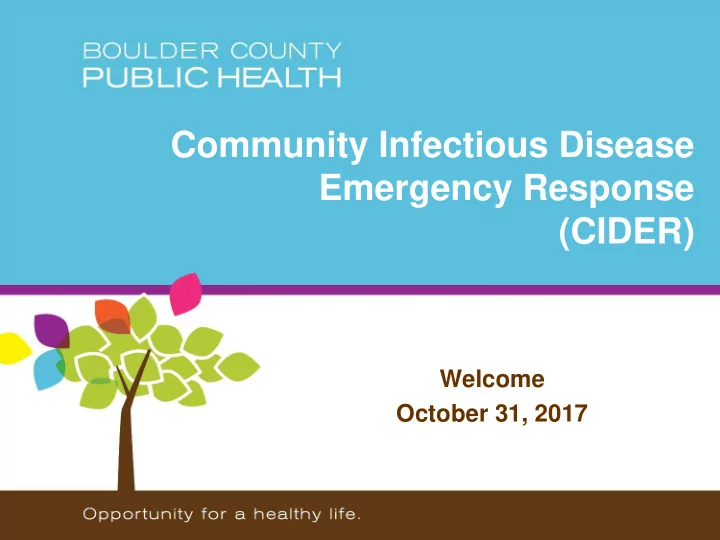

Community Infectious Disease Emergency Response (CIDER) Welcome October 31, 2017
Agenda 8:30 a.m. Welcome & Introductions 8:45 a.m. Previous CIDER Work 9:00 a.m. Antibiotic Resistant Disease Annex/HAI Discussion 9:45 a.m. CLIP Grant & Long Term Care Outreach 10:00 a.m. Pandemic Influenza Planning 10:20 a.m. Next Steps & Outbreak Updates
Previous CIDER Work
Infectious Disease Emergency Response (IDER) Plan • Provides a framework and standardized approach to infectious disease planning • Outlines the authority, processes, and management structure of an infectious disease response in our community • IDER is the toolbox which organizes the tools available to public health
When is the IDER Plan Used? “IDER Plan is intended to be used for any infectious disease emergency that requires a response that exceeds the normal disease control capacity of the CDEM Division, or presents a significant threat to the community. The IDER Plan is intended to be used for any infectious disease emergency that requires a response or planning initiative.”
CIDER Team • Your Role: – Input to the planning process – Participation in events and trainings – Serve as a conduit to your organizations and peers – Facilitate bidirectional communication • Annual meeting
Community Infectious Disease Risk Assessment
IDER Plan Annexes • Developed Quarantine Support Plan • Updated Community Containment Protocols and Public Health Orders • Completed Respiratory Aerosolized Transmission (RAT) – RAT Disease Table • Next: – Antibiotic Resistance (AR) / Healthcare- Associated Infections (HAI)
Antibiotic Resistance/ Healthcare Associated Infections
Healthcare-associated infections (HAI) Outbreaks Hospital Outbreak Community Outbreak • • Infection Prevention leads LPHA leads • • Internal to healthcare External congregate system settings: • – LTCF, schools, child Partner with CDPHE care, home health, – LPHA long term goal outpatient clinics, • Surveillance and control shelters, jail, dorms, – Assist as needed group homes • Routine prevention and • Not routine response – Prevention and response • Need CIDER technical assistance
Infection Prevention • What organisms are the biggest concerns for your facility? – For the community? • What clinical care areas are the greatest risks? • What are some strategies that you do to mitigate infections? • What are some strategies that you do to prevent infections? – Any ongoing efforts of antibiotic stewardship? • Have you ever experienced a HAI outbreak? – What were some lessons learned?
Long Term Care Facilities (LTCF) • How do you communicate with LTCF about HAI for patient transfers? – Do LTCF communicate to you? • Are there any challenges with HAI in LTCF that you think need addressed?
Antibiotic Resistant Disease Annex • NACCHO HAI Toolkit – HAI Outbreak Investigation Protocols – HAI Prevention & Reference Manual – HAI Outbreak table-top exercise • Focus areas? • Specific infections? • Need input from hospitals and LTCF
CLIP Grant & Long Term Care Outreach
Colorado Local Public Health Agencies for Infection Prevention (CLIP) Objectives: • Improve HAI/AR infrastructure in CO • Improve healthcare and community infection control • Enhance coordination of HAI and AR prevention efforts
CLIP Initiative Goals • Increase knowledge via training opportunities • Increase collaboration among CDPHE and LPHAs during investigations of HAI outbreaks • Infection prevention assessments in facilities within the LPHA jurisdiction • Assist LPHAs in gaining an understanding of local HAI surveillance data to help determine local prevention priorities
Boulder County CLIP Activities • Attended APIC & CDPHE trainings • Gathered information from LTCF (qualitative assessment) • Delivered HAI and infection control trainings for LTCF • Disseminated HAI aggregate data via Epi-Connections newsletter
LTCF Infection Prevention Qualitative Assessment • Leadership and policies are supportive • CMS regulation changes • CDPHE infection prevention assessments • IP Challenges: – Staff adherence to precautions, hand hygiene, patient communications, handling infectious waste, staff turnover, access to medical records • Specific infections: – Increasing post-surgical sites, wounds, prevention of UTIs • LPHA support: – Trainings, surveyor questions, surveillance systems
Pandemic Influenza Planning
Pandemic Preparedness Efforts • Boulder County Pandemic Plan Review • Recent BCH Pan Flu Tabletop Exercise • Healthcare Coalition Medical Surge Exercise in 2018 • Statewide Mass Vaccination Exercise in 2020
Next Steps
Next Steps • Develop AR/HAI annex • Solicit review and feedback from CIDER Team • Updates: – Outbreaks – Seasonal flu
Thank you!
Recommend
More recommend